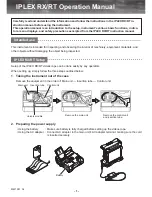
Section 14: SCPI command reference
Model 6517B Electrometer Reference Manual
14-100
6517B-901-01 Rev. C / August 2015
[:EVENt]?
This command is used to read event registers.
Usage
:STATus:MEASurement[:EVENt]?
:STATus:QUEStionable[:EVENt]?
:STATus:OPERation[:EVENt]?
:STATus:OPERation:TRIGger[:EVENt]?
:STATus:OPERation:ARM[:EVENt]?
:STATus:OPERation:ARM:SEQuence[:EVENt]?
Details
These query commands are used to read the event registers. After sending one of these commands
and addressing the Model 6517B to talk, a decimal value is sent to the computer. The binary
equivalent of this value determines which bits in the appropriate register are set. The event registers
are shown later in this command description. Note that reading an event register clears the bits in that
register.
For example, assume that reading the transition filter event register results in an acquired decimal
value of 544. The binary equivalent is 0000001000100000. For this binary value, Bits B5 and B9 of
the transition filter event register are set.
The significance of a set bit in these registers depends on how the transition filter is programmed. If
an event is programmed for a positive transition (PTR), the corresponding bit in this register sets
when the event occurs. If the event is instead programmed for a negative transition (NTR), the bit
sets when the event becomes not true.
Measurement event register:
Bit B0, reading overflow (ROF): Set bit indicates that the reading exceeds the measurement range of
the instrument (PTR), or the instrument has gone from an overflow condition to a normal reading
condition (NTR).
Bit B1, low limit 1 (LL1): Set bit indicates that the reading is less than the low limit 1 setting (PTR), or
that a subsequent reading is no longer less than the low limit 1 setting (NTR).
Bit B2, high limit 1 (HL1): Set bit indicates that the reading is greater than the High Limit 1 setting
(PTR), or that a subsequent reading is no longer greater than the High Limit 1 setting (NTR).
Bit B3, low limit 2 (LL2): Set bit indicates that the reading is less than the low limit 2 setting (PTR), or
that a subsequent reading is no longer less than the low limit 2 setting (NTR).
Bit B4, high limit 2 (HL2): Set bit indicates that the reading is greater than the High Limit 2 setting
(PTR), or that a subsequent reading is no longer greater than the High Limit 2 setting (NTR).
Bit B5, reading available (RAV): Set bit indicates that a reading was taken and processed (PTR), or
that a subsequent reading is in process (NTR).
Bit B6, reading underflow (RUF): Set bit indicates that the ohms reading is less than the lower range
limit (PTR) or the instrument has gone from an underflow condition to a normal reading condition
(NTR).
Bit B7, buffer available (BAV): Set bit indicates that there are at least two readings in the trace buffer
(PTR), or the buffer has become empty (NTR).
Bit B8, buffer half-full (BHF): Set bit indicates that the trace buffer is half-full (PTR), or that the buffer
is no longer half-full (NTR).
















































